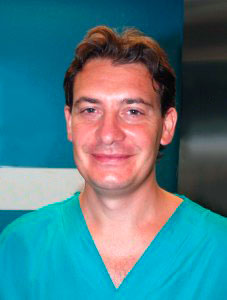
ENT surgey
In the operating rooms of the ENT department of the Candiolo-IRCCS Institute, the patients of Dr. Bondi can be subjected to:
Surgery of the oral cavity - oropharynx - nasopharynx:
demolition interventions with reconstructions using pedunculated or free flaps for malignant pathology
tonsillectomy
adenoidectomy
uvulopalatoplasty, anterior-lateral pharyngoplasty for OSAS
exeresis-biopsy of neoformations
Ear surgery
otoplasty
placement of transtympanic drainages
exeresis of benign and malignant neoformations of the pavilion earphone or ear canal
Surgery of the larynx and hypopharynx
exeresis biopsy of neoformations of the vocal cords with CO2 laser, both of benign and malignant origin
posterior ventriculocordotomy
total or subtotal laryngectomies
pharyngolaryngectomies
speaking valve placement
tracheotomies
Surgery of the neck and salivary glands
total or superficial parotidectomy
removal of the submandibular or sublingual gland
laterocervical emptying
exeresis-biopsy of neoformations of the neck (of lymph node origin, branchial cysts, thyroglossal duct cysts, lymphangiomas)
total thyroidectomy, hemithyroidectomy
Nasosinus surgery:
Removal of nasosinusal neoformations (subtotal or total maxillectomies with possible sacrifice of the orbit)
Septoplasty
Surgery to correct the deviations of the cartilage and bone structures that make up the nasal septum, which cause respiratory disorders and favor the chronic pathology of the paranasal sinuses.
The operation takes place under anesthesia general, an incision is made at the level of the septal mucosa, not visible from the outside. Through this incision the cartilage and bone segments representing the deviation are removed. The mucosa is sutured with absorbable threads and, on the sides of the septum, plastic plates are placed, fixed with a silk thread.
In selected cases, the procedure can be performed under endoscopic guidance, in a mini- invasive and sometimes without positioning of the plates.
In about 40% of cases, to avoid the risk of bleeding, tampons are placed which completely occlude the nasal cavities.
Most patients are molded and discharged. 'the day after the procedure, the first outpatient check-up takes place after 9-12 days during which the para-septal plates are removed. The improvement in breathing is generally already noticeable after the removal of the plates and becomes optimal after about 30 days from the procedure. The surgery has no implications for the appearance of the nasal pyramid.
Turbinoplasty
Volume reduction surgery of the inferior turbinates, bony structures, lined with mucosa that are located in the lower portion of the lateral wall of the nasal cavity. Their hypertrophy causes nasal respiratory obstruction and fovor the chronic pathology of the paranasal sinuses.
The operation is performed under local anesthesia or under general anesthesia if associated with septoplasty or FESS.
In case it is performed under anesthesia local discharge occurs after a short period of observation in the ward. The procedure is generally well tolerated and can be repeated several times over the course of a lifetime.
Nasosinusal functional endoscopic surgery
Surgery aimed at improving the ventilation of the paranasal sinuses and removing any polypoid neoformations that may be present. The procedure is normally performed under general anesthesia. In selected cases of recurrent polypoid rhinosis, unblocking can be performed under local anesthesia.
The procedure is performed under endoscopic guidance with high-resolution technology, in order to accurately visualize all the regions and recesses of the nasal cavities and sinuses. paranasal.
In about 40% of cases, to avoid the risk of bleeding, tampons are placed which completely occlude the nasal cavities.
Most patients are molded and discharged the day after the procedure, the the first outpatient check-up takes place after about 7 days.
Correction of nasal valve insufficiency (batten graft technique)
In some subjects the nasal valve may be insufficient and may cause a more pronounced nasal respiratory obstruction in the inspiratory phase.
